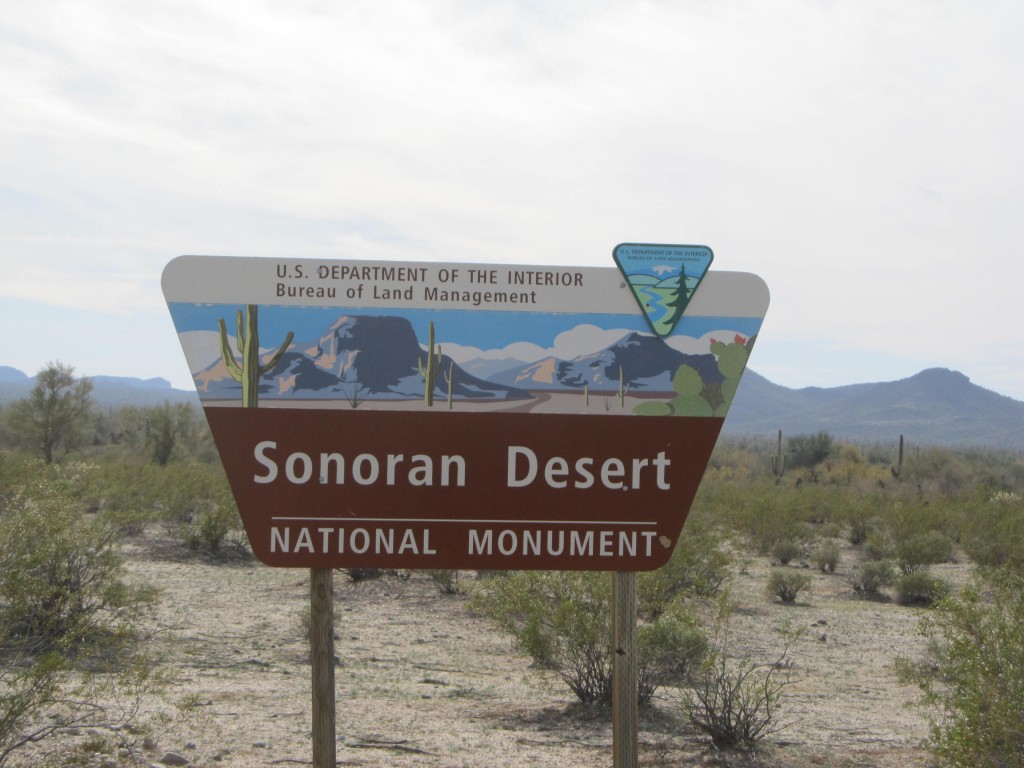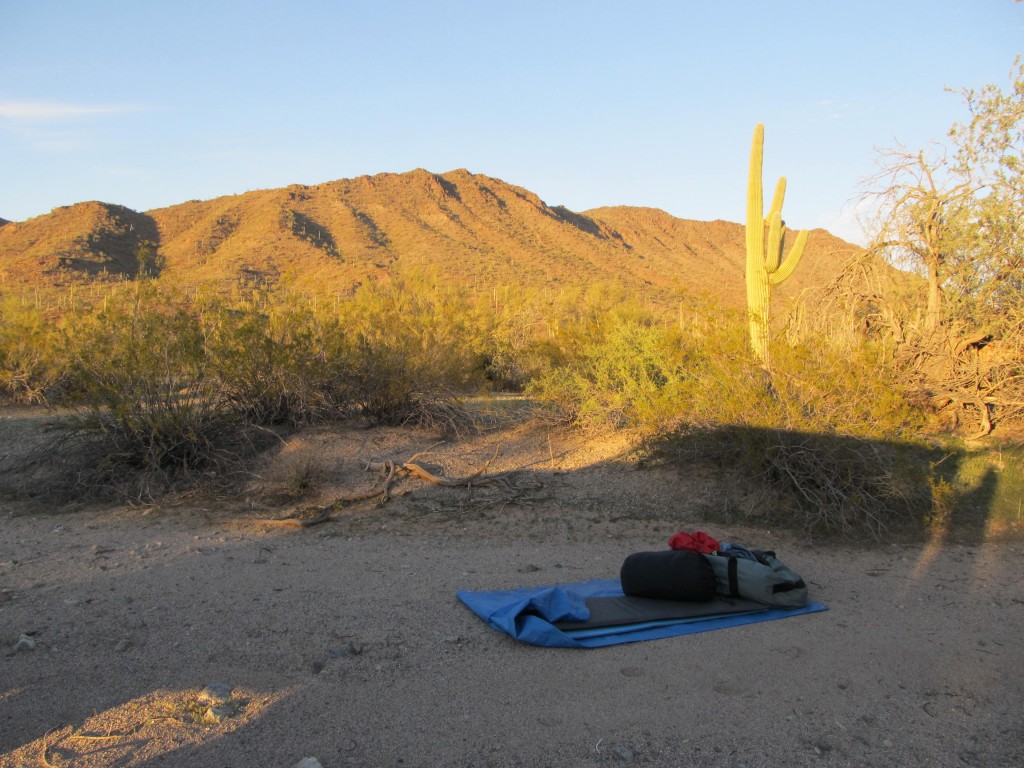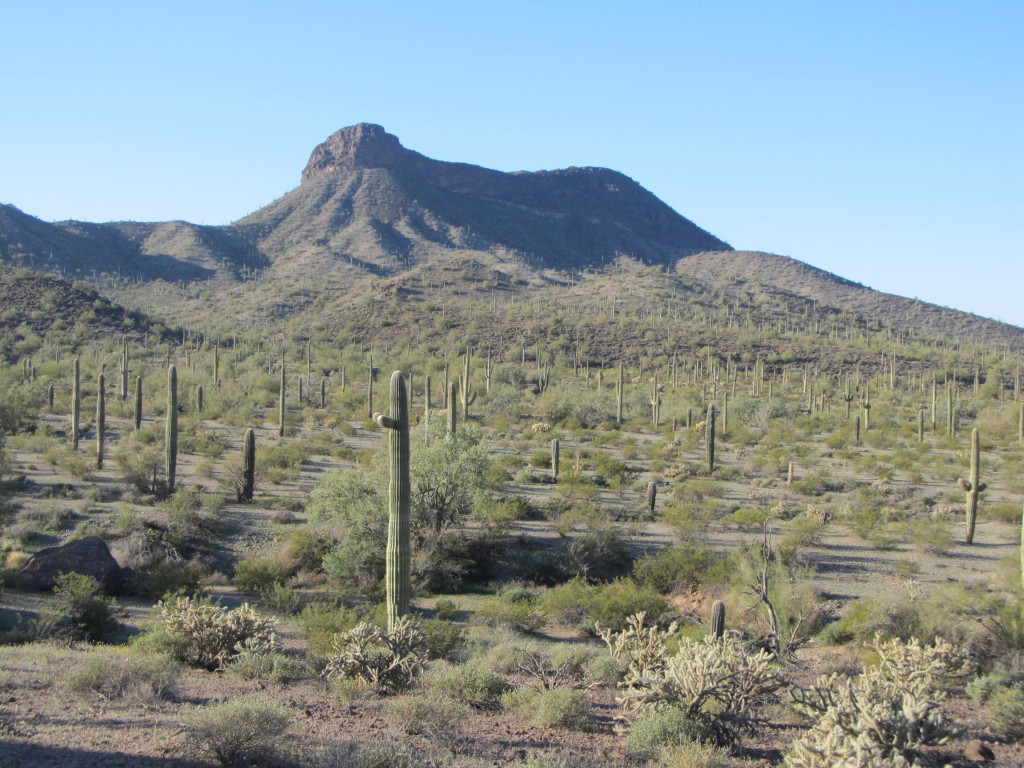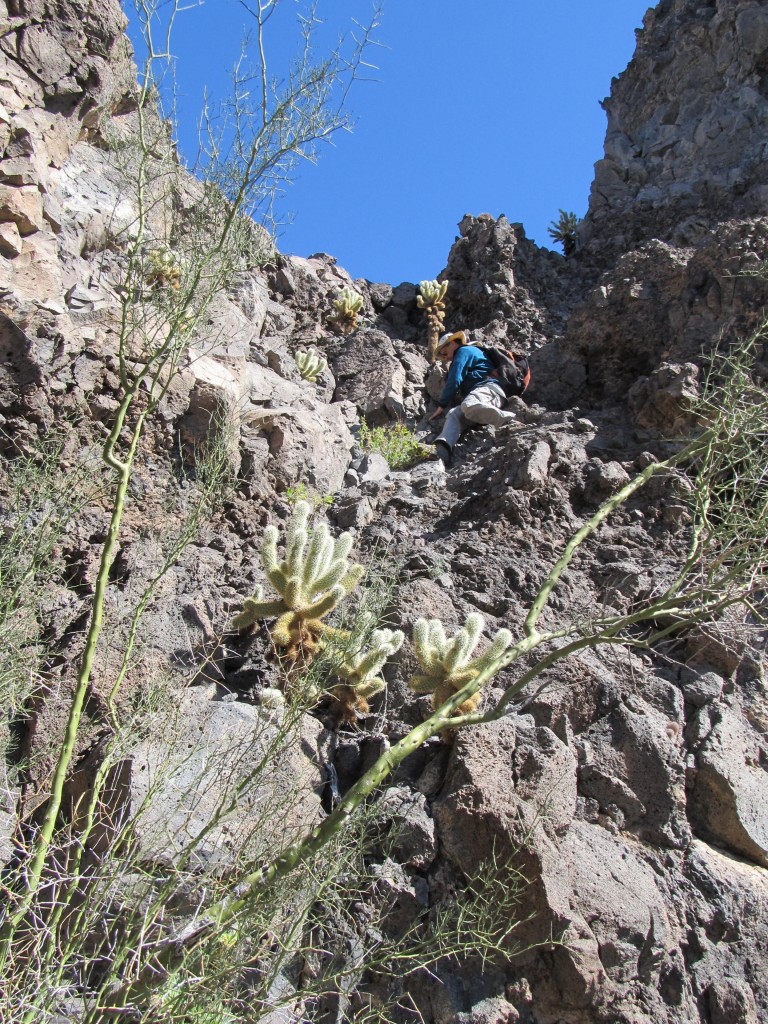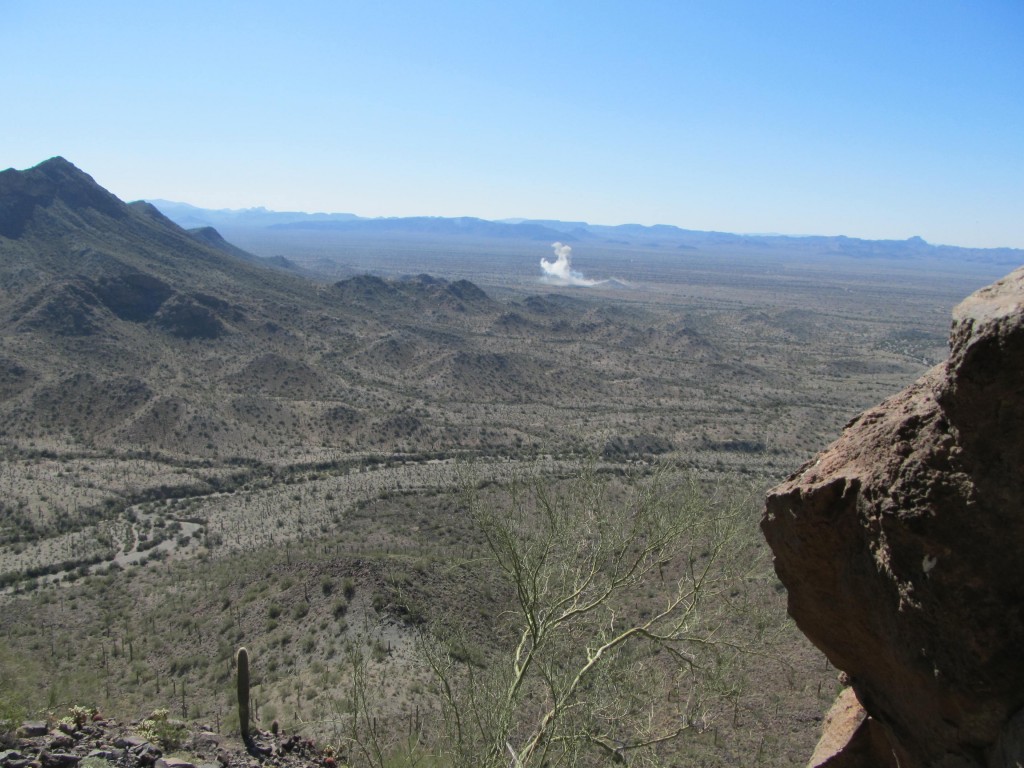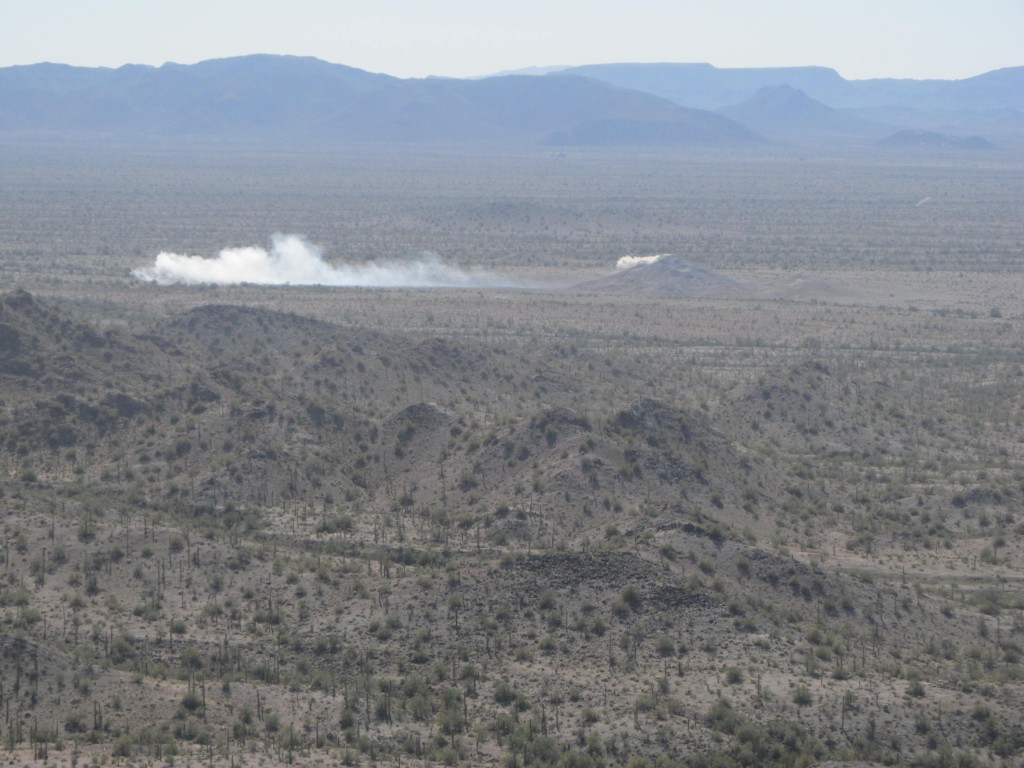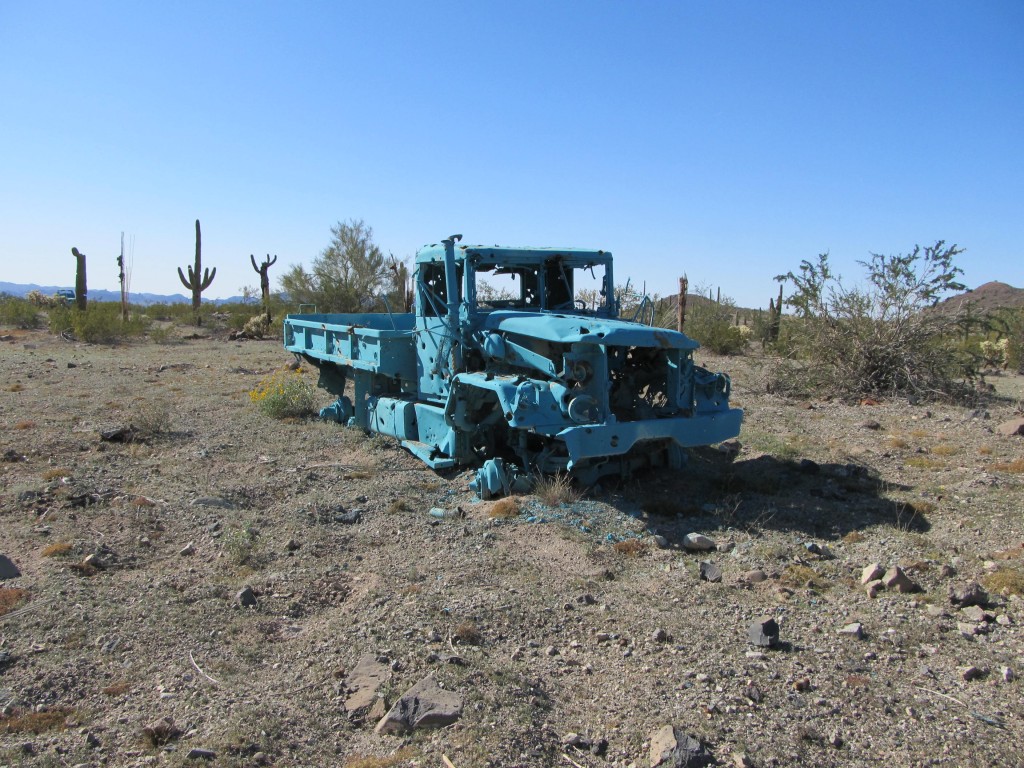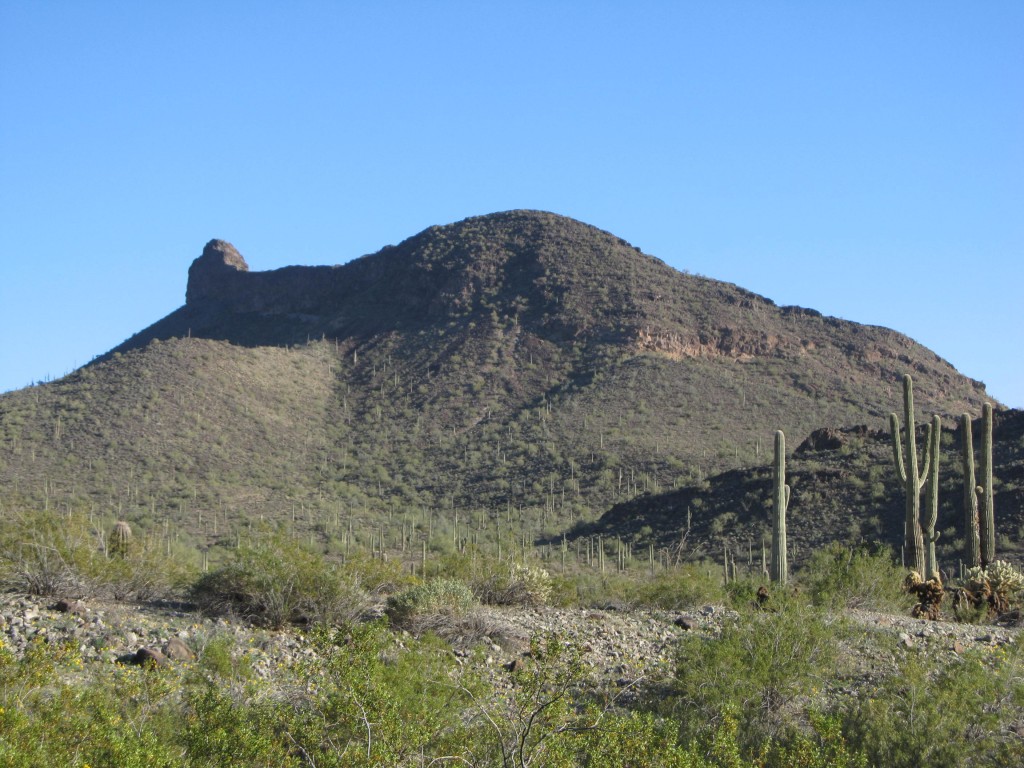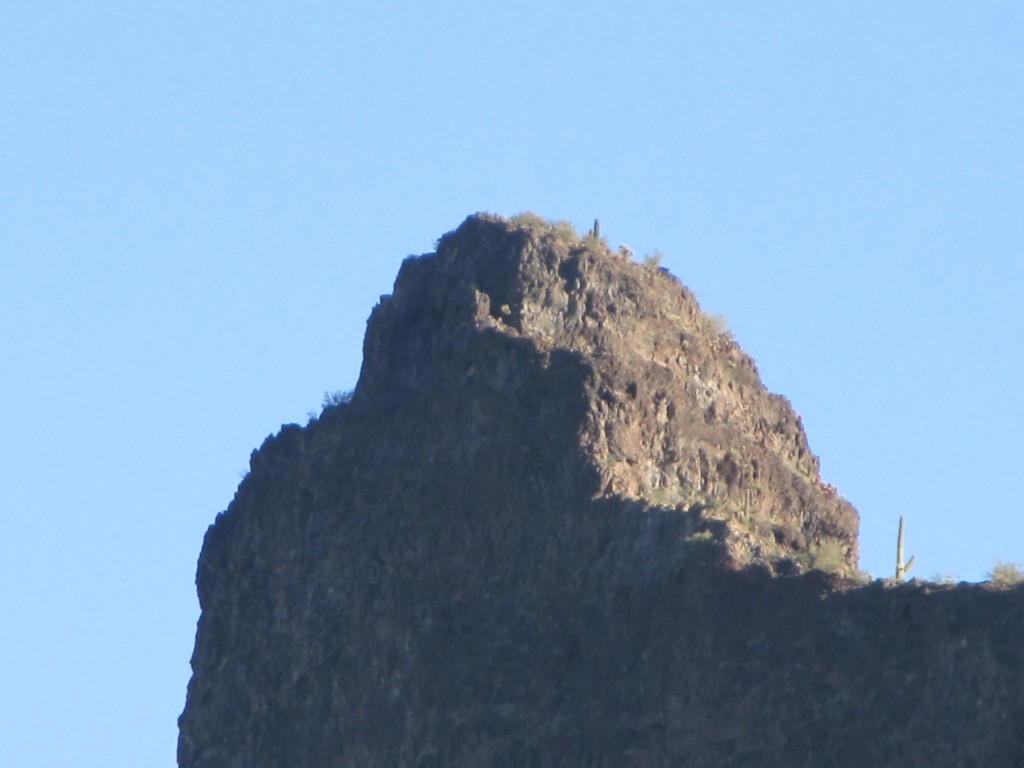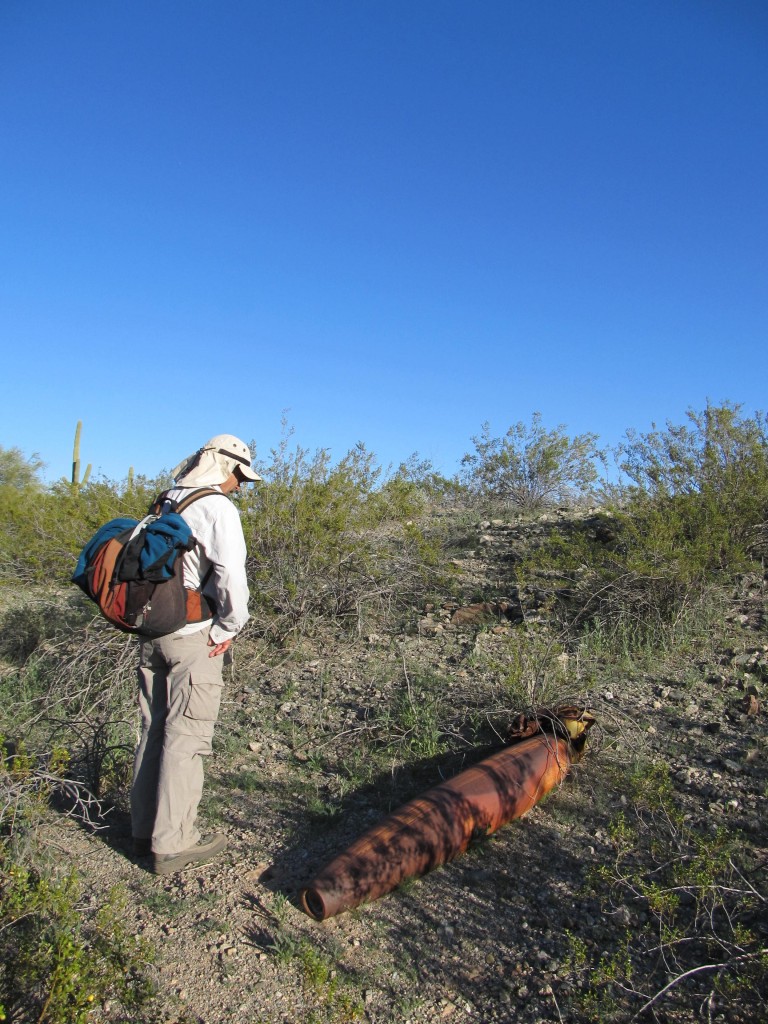Christmas was approaching. My climber friend in California was telling me he was thinking about his next major peakbagging trip, although he hadn’t yet decided on the destination. I suggested a place with lots of peaks in a remote part of the desert, very pristine and unspoiled – the Sand Tank Mountains. He mentioned it to a few other friends, and before long we had put together a team. There would be three of us – myself (the Desert Mountaineer, or DM), Benchmark and Rhiker – I was from Tucson, they were from San Diego.
On January 31, we met at Big Horn. This is simply a name on the map, and all that is there, and ever was there, is one old house and a corral. It is right beside the Interstate. It was a nice reunion, as we hadn’t seen each other in a couple of years – not since we had attended the funeral of a friend who had died while climbing with us in the Plomosa Mountains a few years earlier. After a few minutes of strategizing, we set out in the two vehicles, both Toyota four-wheel-drive pickups, staying in constant radio contact. We soon passed this sign on the way in.
Our road headed southwest, and in 3.7 miles of easy driving on the dirt road we arrived at the boundary of the Barry M. Goldwater Bombing Range. In order to legally enter this area, you need to first sign a hold-harmless agreement with the U.S. Air Force. In a nutshell, that means that if you play around with unexploded ordinance and blow your leg or head off, that’s your problem, and neither you nor your heirs can sue them. And trust me, there’s all kinds of scary stuff lying around – it’s everywhere, and you don’t have to look hard to find it. It could be lying on top of the ground, or hidden just below the surface – either way, one wrong step and you’re dead.
Travel now was across-the-grain, that is to say, at a right angle to the countless gullies which had formed over millenia and lay in our path. Although it was only eight miles more to the long-abandoned Papago Indian Chief mine, it felt like a hundred. Up, down, up, down, in and out of endless washes, constantly shifting gears, sometimes needing four-wheel-drive, mostly not. It seemed like forever had passed by the time we reached the easier ground near the mine. We didn’t have any plans to linger there, it was just a marker along the way. Two and a half miles more on pretty flat roads and we had arrived at a camp-site that couldn’t be beat – a sandy wash secluded by thick vegetation, with lots of dead wood for a campfire.
As the crow flies, we weren’t so many miles into the range, but we might as well have been on the dark side of the moon. During the week we were to spend in this area, we didn’t encounter another soul. The desert has a way of swallowing you up, making you feel like you’re the last survivor of some holocaust. Not even the Border Patrol found us. This seemed like the sort of place you could survive the zombie apocalypse. We had our permits from the gummint and not much else mattered.
The sun was setting, we had a campfire going, and it was happy hour. The booze flowed like water, we had plenty of good food and maps to pore over. Great tunes blared from the truck stereo as we planned the next day’s climbing. The Milky Way seemed like you could reach up and grab it in the inky-black sky. Honest to God, it doesn’t get any better than this. We slept like the dead, Benchmark directly on the sand, Rhiker and I in the beds of our trucks. No need to be much covered up, as there were no bugs to bother us.
We awoke at dawn to a light frost, and of course a clear blue sky – hey, it’s the desert – what else would you expect, clouds? Getting ready to set out for the day only took half an hour, and we were psyched. Our main objective for the day was a little-known peak called Jack in the Pulpit.
Heading south from camp, we passed through gently rolling country, over a low pass, then down into a major sandy wash. We decided against following this wash, even though it would have offered quick travel with its wide sandy bottom – it would have taken us too far out of our way. Our peak loomed 1,000 vertical feet above us, and gave us pause. Its entire north side was barred by huge rotten cliffs. We knew what we had to do, and that was to outflank it on its west end. A long ascending traverse gained us 800 feet, and placed us on the end of the summit ridge.
Whoever named this peak must have thought it looked like the woodland flower of the same name – maybe it does – if you google it, you can see that the flower rises up at one end. As we stood at the west end of the ridge, we could see that we needed to drop down a hundred feet and then rise up steeply to the summit area.
We only knew of one person who had summited this thing, and that was our friend AZB, and he had done it solo and unprotected. He had a reputation as a pretty fearless and very driven climber, and we figured that with the beta we had from him, we could pull it off. Now when AZB says something is Class 3, you can count on it. If he says it’s Class 4, you’d better expect some scary stuff. By the way, most climbers consider Class 3 to be difficult enough that you are looking for handholds and footholds, and there is enough exposure that if you fall you will probably break something or get seriously hurt. By the same token, Class 4 means that prudent parties will rope up, and there is enough exposure that an unprotected fall will probably kill you.
We walked down into the small saddle, then continued uphill over to the highest part of the mountain. For weeks leading up to this day, I have to confess that we had been worried about what we would find when our faces were up against the rock, and this was the moment of truth. Sheer cliffs dropped off both the north and south sides, and this meant that there was only one possible way up this thing, and it had better work. We found ourselves at the base of some very steep rock, loose and gritty, and studded with cactus. I don’t remember who went up first, but it wasn’t me.
Well, after maybe ten minutes, all three of us had climbed up this steep 60-foot stretch of Class 3-4 and were huddled together on a small shelf of rock. It wasn’t over yet. The worst was yet to come, and it didn’t look good. I felt disheartened as I looked up at the last bit. AZB had said the crux of the climb would be here, that this last part would make us or break us. We shouldn’t have been too disappointed with what we saw, because he is an understated kind of guy – he had said it was Class 4, and we should have been expecting a serious challenge. To be honest, I was discouraged, and unsure if we were going to make it. The climbing itself looked doable, Class 4 for sure, but the rock appeared fairly weathered and unstable. After studying it for ten minutes, we arrived at a consensus. Climbing over to the left offered slightly more-stable-looking rock, but the downside was that that route was directly over a huge near-vertical drop of over 200 feet, or the height of a 20-story building. The other option was to climb directly up from where we stood – the exposure seemed less (if you fell, you’d bounce once on the rock shelf and then fall into the abyss – small consolation!) but the rock was more rotten. In either case, the actual rock climbing was only about 15 to 20 feet.
We decided to try the left side – at least, with better rock, there was less chance of peeling off. But here’s why we were concerned – no hardware, no way to protect a fall. Also, we didn’t have a proper climbing rope. In fact, all we had was a thin piece of nylon cord someone had brought from home, maybe 4 millimeters in thickness at best. It was more like dental floss than a real rope (which would have been 10 to 11 mm), but it was the best we could do. I volunteered to go first.
With the cord tied around my waist, I started up, not daring to look down between my feet into the gulf. In only a minute or so, it was over and I crawled on to the top. The mountain flattened out abruptly once above the tricky bit, and I was so relieved to be up. After my heart stopped pounding, I set up a crude belay and the other guys followed up in short order. Man, it felt good to be there – we were overjoyed! A short walk brought us to a small cairn, and, sure enough, AZB’s register was there. His was the only entry and likely the first ascent – there was no evidence of any prior, and we knew surveyors had not been there. It was a pleasure to be the second party to sign in. Now all we had to do was get back down.
Using the same big rock as a belay anchor, I tied myself in and then, one after another, the guys downclimbed the part with the crummier rock with the “rope” tied to them. The belay was more psychological than anything else – if someone had fallen, it is likely the rope/floss would not have held them. Once they were down, I set up a sling made of the same cord around the rock and ran the rest of the cord through the sling; so, in effect, I was top-roped while I downclimbed and they belayed me from below. Again, it was a relief to be done with it.
The three of us started to downclimb the 60-foot bit, and were maybe halfway down it when all hell broke loose.
We were minding our own business, being careful so as not to have an accident on the steep rock, when a huge boom occurred and scared the bejeezus out of us. We instinctively grabbed on to the rock to secure ourselves, then looked to the southwest. What to our wondering eyes should appear but an A-10 jet aircraft, affectionately known as a Warthog, two miles away. It had just dived very steeply and had released a large bomb which exploded against a small hill being used for air-to-ground target practice.
The reason we knew all of this was that we saw it repeated over and over again. Those must have been some big-ass bombs, because we could actually see them being released from the planes and fall free, while the pilots quickly pulled the jets out of the dive and climbed away from the hill before the blast occurred. The sound of the bombs going off was deafening – you could feel the concussion of it in your chest. All climbing stopped for a while as we watched this drama unfold – it was spectacular, exciting, awe-inspiring. We finally climbed down to safer ground and ate while the show went on. A chill wind was still blowing, so it was nice to sit in the sun. The photo below is an extreme telephoto taken from our lunch spot. What it shows is a large plume of smoke on the left, drifting away on the wind, from an earlier bomb. Just to the right of center is the little hill which is the bombing target, and you can see a small white puff of smoke on it, from another bomb which has just exploded.
Lunch over, show over, we had to move on. Down into the saddle, then over the west end of the ridge. The easiest way down off the mountain was to lose elevation to the southwest, so this we did, ending up in a large sandy wash. As we continued west, following the easy ground the wash afforded, something colorful caught our eye, something that was a bright robin’s-egg blue. In a few minutes, we arrived at a big truck which was shot full of holes – big holes, from something that was very high-calibre. We guessed that the Warthogs had done it, and that this truck was there solely for target practice.
Then we noticed that farther down the road were other vehicles, a whole string of them in fact, all painted the same blue. They too were all shot up. What an eerie feeling, realizing the hell-fire that must have been unleashed on them from the air. No wonder the Warthog is also known as the “tank-killer”. There were big 18-wheelers, buses and various smaller vehicles too, and all had suffered the same fate.
It was obvious we had made a mistake and had wandered into an area that was off-limits, so we left immediately, crossing a flat area to the north. In less than a mile, we arrived at a hill shown as 1875′ on the map, and, since it was there, we climbed it. By the time we got to the top, we were starting to feel all played out. I don’t remember if we left a register, probably not, but we did build a cairn. Down the gritty north side, we soon arrived at the major sandy wash we had used early in the day – it would now serve as an avenue to return to camp.
You might think that it would be easy to walk up a nice, wide sandy wash – mmmm, not so much. Because the sand is soft and gives under foot, you actually can expend more energy than walking on a firm surface. We were really happy that we had climbed our big peak for the day, and talking about that seemed to make the time pass more quickly. The picture below shows a telephoto of the summit. The crux of the climb is the part in shadow just to the left of the line separating light from dark, just below the highest part seen in the picture.
More than a mile had passed when something large and brown caught our collective eye. Right next to the wash was a huge bomb, unexploded, sitting there for who-knows-how-long. It was very rusty, but probably still quite capable of exploding. It was a full six feet long. We gawked at it, but there was no way we were going to touch it.
The day was getting late, so we moved on. We spent two miles in that wash, and by the time we left it by climbing its steep northern bank, I for one felt done in. Another mile through several small gullies returned us to our camp, but there was still one more thing to do. Earlier, we had decided that we would be better situated for another brutal day if we were to move our camp a couple of miles farther east. That done, the first beer tasted especially good while we gathered dead wood for a fire. We had been out over 8 1/2 hours on foot, and my dogs were barkin’, but more alcohol eased the pain. Sleeping well was not a problem that night. Stay tuned, because we were about to spend almost another week in this remote desert.
To be continued…………………..
Please visit our Facebook page at https://www.facebook.com/pages/Desert-Mountaineer/192730747542690

